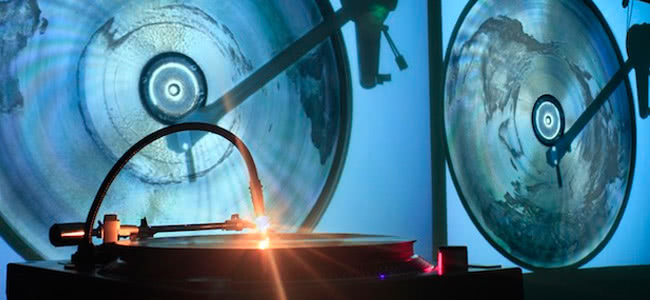It turns out the earth really is flat. At least, it is when you put it onto a vinyl record.
The bizarre concept came from arts group Art Of Failure, who came up with a pretty interesting project called the “Flat Earth Society” where they mapped the worlds topography (mountains, hills, valleys etc..) into the grooves of a vinyl record.
The resulting records, a series of scratches, blips, and glitches, was put on display at an exhibition where the group modified a turntable so that each side of the record took half a day to play, reflecting the speed of the Earth’s rotation around its own axis.
So how did they do it?
According to Alan Cross, the Flat Earth Society set about transposing the Earths elevation across continents into the scale of the grooves on a microgroove record. Each side of the 33 rpm record is a transfer of a hemisphere, so one record was for the southern hemisphere while the other reflected the northern hemisphere.
The group sourced data about the Earths elevation from NASA’s databases, and converted the data into an accurate audio waveform using computer software.
The resulting sound file was then dirtily engrave on a dub plate (record) using a modified record lathe. This engraving of elevation’s data on the surface of the disk generated a subtle image of the earth, and allowed any standard turntable to be able to play the record.
While playing, the chain of elevation data crossed the the needle can be heard, thus producing the “sound” of the Earth.
The project’s Douglas Kahn described the phenomenon. “Can we hear the Earth? Not the sounds occurring upon it but the Earth on a geophysical scale? The hill-and-dale technique was used in Edison’s phonograph, recording sound with a stylus that vertically cut a minute landscape into the grooves of the cylinder.”
“Flat earth society takes readings from the stylus of topographic radar, cuts them into vinyl and then plays them back with a stylus. Phonographic hills-and-dales grow into the Alps, Andes, Himalayas, Grand Canyon, Great Steppe, Great Rift Valley, Great Outback and the Lesser Antilles.”
“Peaks and valleys, spikes and wells, spires and troughs, aspirations and depressions, all have their gradations in mythical and actual landscapes.”
Kahn claims that if you listen closely enough to will begin to recognise pattens corresponding to the relief of the crossed continents, although mostly the earth sounds very scratchy.
It’s not the only innovative idea using vinyl records and new technology. 3D printing which has been quickly gaining momentum has also seen a number of experimenters use vinyl.
For example, Instructables researcher and DIY project maker Amanda Ghassaei recently found a way to turn any mp3 into a 3D printed record, using tJoy Divison’s songs ‘Disorder’ and ‘Love Will Tear Us Apart’ to demonstrate the new technique.
Art Of Failure also filmed themselves playing the two records simultaneously, which is handy if you’re looking to hear the whole world at once. You can take the world for a spin yourself below.
EARTH TO DISK – 2 SIDES from art of failure on Vimeo.

































